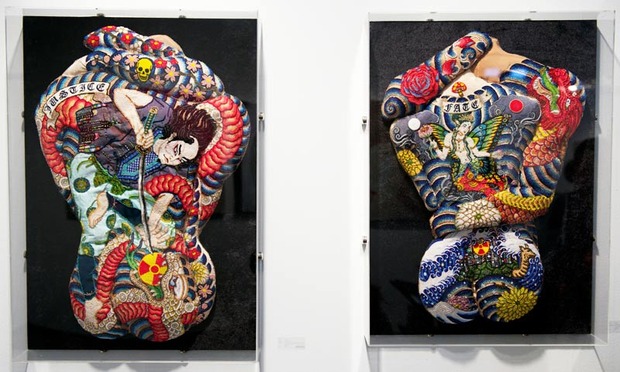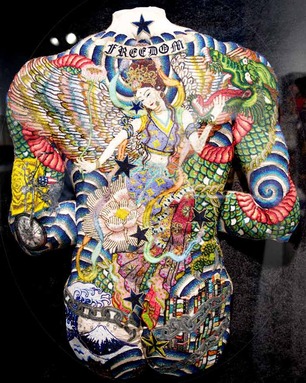Eri Imamura
Taboos, tattoos and Native American beadwork from a Japanese artist


A serial experimenter, Eri Imamura‘s work marries disparate elements of mythology, Native American beadwork and tattoo culture to create life-sized textile sculptures. Collectively, they deal with man’s delicate relationship with nature, his propensity for materialism and Japan’s collective suffering following the 2011 earthquake. Found at La Lanta Fine Art, each of Imamura’s pieces uses symbolic imagery to communicate a statement, with proceeds from the sales going to support the relief effort. “Justice” addresses the problem of nuclear energy in Japan, with a man brandishing a sword that points either to a white snake or the nuclear symbol. “Fate” posits that Japan’s second nuclear disaster could be punishment for wrongs against the natural world, and “Freedom” lightens the series with a prayerful hope of regeneration and freedom from desire.
Intrigued by the artist’s fascinating process and cultural ambition, we caught up with Imamura to learn more about her work.

How did you first get involved with Native American beadwork?
I went to New Mexico to study Native American culture as well as beading at the Institute of Native American Art in Santa Fe. In Japan, Native American art and culture are very popular and there are a number of books focused on Native American philosophy and spirituality. I found a significant connection between both cultural traditions. In Shinto, Japanese find the deities (Kami) everywhere in nature: trees, stones, water, clouds, wind, space and animals. Native Americans likewise find sacred elements such as spirits in nature.
What is your relationship to Japanese tattoo art?
Japanese tattoo is a remarkable Japanese tradition. It is said that the tradition began more than a thousand years ago. Originally tattoos were a symbol of bravery and manhood that were used among artisans, carpenters, firefighters, and gangs. Nowadays, mostly those who rule local communities, gangs and firefighters have tattoos. They wear tattoos as a symbol of their spirituality. Usually they don’t show off their tattoo except during special occasions such as festivals because the tattoo is for their own spirituality.
Also, I see some kind of creative freedom in tattooing and Japanese taboo underground culture. I’m very interested in the twisted fact that we keep a very pure and original Japanese cultural element within one of our biggest taboos. Japanese tattoo is a taboo tradition. In this taboo art form, I can free myself from narrow-minded Japanese cultural rules and traditions and gain courage to speak out and make changes in society. I believe that taboo can be a creative power of change.
Tell us a bit about the process.
I use two thread spot stitch appliqué techniques. I first thread the beads and tack down them with a second thread into the shape I want for the textile. It’s very time-consuming work. It takes me months to finish a piece. In that way, I think it is similar to Japanese embroidery, or Sashiko. Both are time-consuming and because of that both are meditative works.
Images by Josh Rubin












